A Christmas Carol
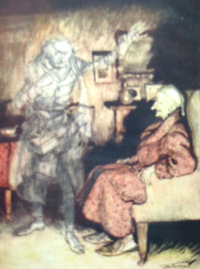 I have endeavoured in this Ghostly little book to raise the Ghost of an Idea which shall not put my readers out of humour with themselves, with each other, with the season, or with me. May it haunt their house pleasantly, and no one wish to lay it. Their faithful Friend and Servant, C.D. December, 1843
I have endeavoured in this Ghostly little book to raise the Ghost of an Idea which shall not put my readers out of humour with themselves, with each other, with the season, or with me. May it haunt their house pleasantly, and no one wish to lay it. Their faithful Friend and Servant, C.D. December, 1843
A Christmas Carol , describing the redemption of the wretchedly miserly Ebenezer Scrooge, is the best known of Charles Dickens' works and has become a Christmas tradition loved by children and adults alike.
Left: Scrooge is visited by the ghost of Jacob Marley. Illustration by Arthur Rackham.
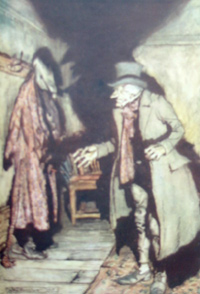 It is composed in five staves, of which the central three describe Scrooge's visitation by three Spirits - the Spirit of Christmas Past, the Spirit of Christmas Present, and the Spirit of Christmas Yet to Come. The remaining staves act as prologue and epilogue.
It is composed in five staves, of which the central three describe Scrooge's visitation by three Spirits - the Spirit of Christmas Past, the Spirit of Christmas Present, and the Spirit of Christmas Yet to Come. The remaining staves act as prologue and epilogue.
Dickens began writing the Carol in October 1843 and had finished it by the end of November so that it could be published for the Christmas season of that year. The author took special pains to ensure that it was produced of the best quality but priced at a level that enabled it to be enjoyed by the widest possible audience. This meant that, although the book was popular from the start, it produced relatively modest revenues for the author who had arranged the finances of the publication himself. The original illustrations were provided by John Leech who had worked on the magazinePunch and acted in Dickens' amateur dramatics.
Right: The lodgings of Ebenezer Scrooge. Illustration by Arthur Rackham
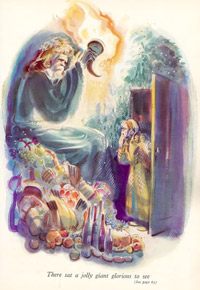 We are introduced to Ebenezer Scrooge, miser and man of 'business' (though the exact nature of the business is never made explicit) in no uncertain terms - "Oh! But he was a tight-fisted hand at the grindstone, Scrooge! A squeezing, wrenching, grasping, scraping, clutching, covetous old sinner!" Scrooge is the surviving partner of the firm Scrooge and Marley, following the death of Jacob Marley exactly seven years previously - "Old Marley was as dead as a door-nail... There is no doubt that Marley was dead. This must be distinctly understood, or nothing wonderful can come of the story I am going to relate."
We are introduced to Ebenezer Scrooge, miser and man of 'business' (though the exact nature of the business is never made explicit) in no uncertain terms - "Oh! But he was a tight-fisted hand at the grindstone, Scrooge! A squeezing, wrenching, grasping, scraping, clutching, covetous old sinner!" Scrooge is the surviving partner of the firm Scrooge and Marley, following the death of Jacob Marley exactly seven years previously - "Old Marley was as dead as a door-nail... There is no doubt that Marley was dead. This must be distinctly understood, or nothing wonderful can come of the story I am going to relate."
Left: Scrooge marvels at the bounty of the Spirit of Christmas Present.
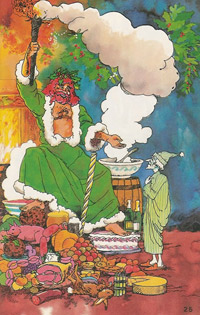 In life, Jacob Marley had been as miserly and self-absorbed as Scrooge and as a direct consequence he had suffered great torments in the afterlife. Marley's ghost visits Scrooge to offer him a chance of salvation, an opportunity to avoid the same fate as Marley if he is prepared change his lifestyle. Initially reluctant to believe his senses, Scrooge blames the spirit's appearance on indigestion - "You may be an undigested bit of beef, a blot of mustard, a crumb of cheese, a fragment of an underdone potato. There's more of gravy than of grave about you, whatever you are!" Finally convinced, Scrooge is told to expect three Spirits...
In life, Jacob Marley had been as miserly and self-absorbed as Scrooge and as a direct consequence he had suffered great torments in the afterlife. Marley's ghost visits Scrooge to offer him a chance of salvation, an opportunity to avoid the same fate as Marley if he is prepared change his lifestyle. Initially reluctant to believe his senses, Scrooge blames the spirit's appearance on indigestion - "You may be an undigested bit of beef, a blot of mustard, a crumb of cheese, a fragment of an underdone potato. There's more of gravy than of grave about you, whatever you are!" Finally convinced, Scrooge is told to expect three Spirits...
Right: Illustration by Chris Russell
The first spirit, the Ghost of Christmas Past, shows Scrooge scenes from his past including a Christmas party held by Mr. Fezziwig for whom he worked as an apprentice. The pleasure generated by the party was considerable yet the financial outlay to Mr. Fezziwig was relatively modest. Scrooge is deeply affected - "His heart and soul were in the scene, and with his former self. He corroborated everything... and underwent the strangest agitation." Scrooge wonders whether he should not have treated his clerk, Bob Cratchit, more kindly at Christmas...
The second spirit, The Ghost of Christmas Present, takes Scrooge to the house of his ill-treated clerk Bob Cratchit. Despite this family's poverty, the household derives joy from simple pleasures - though a sense of impending darkness is provided by the description of Cratchit's crippled son, Tiny Tim. "I see a vacant seat," replied the Ghost, "in the poor chimney corner, and a crutch without an owner, carefully preserved. If these shadows remain unaltered by the Future, this child will die." Scrooge is distraught (again we witness signs of his transformation) but the Spirit uses Scrooge's earlier words against him - "If he be like to die, he had better do it, and decrease the surplus population."
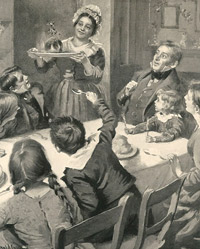 At the end of the third stave, the Spirit draws aside his cloak to reveal two piteous children - "This boy is Ignorance, This girl is Want." Scrooge recoils in disgust, asking whether there is no refuge for the two waifs, and again is rebuffed by the Spirit using his own words against him - "Are there no prisons? ...Are there no workhouses?" The Ghost of Christmas Past makes way for the third, and most disturbing, Spirit...
At the end of the third stave, the Spirit draws aside his cloak to reveal two piteous children - "This boy is Ignorance, This girl is Want." Scrooge recoils in disgust, asking whether there is no refuge for the two waifs, and again is rebuffed by the Spirit using his own words against him - "Are there no prisons? ...Are there no workhouses?" The Ghost of Christmas Past makes way for the third, and most disturbing, Spirit...
Left: Illustration by Harold Copping
The Ghost of Christmas Yet to Come is the spirit which Scrooge fears the most, and it has an appropriately troubling appearance - "draped and hooded, coming like a mist along the ground towards him." In his company, Scrooge is shown the reactions of various groups to the death of an unidentified man. No one appears to show any sympathy for his death and Scrooge wonders whom they may be discussing, though there is a suggestion that he may have his suspicions - "The case of this unhappy man might be my own. My life tends that way now."
In contrast to the un-mourned death of this unnamed man, the Spirit shows Scrooge the household of Bob Cratchit where Tiny Tim is no longer present. The scene is described with the utmost poignancy by Dickens, but Scrooge's reaction to the scene is not recorded. Instead the Spirit draws Scrooge to a neglected grave - "choked up with too much burying; fat with repleted appetite". As Scrooge confronts his own name on the grave, he promises that the intercession of the Spirits has changed him - "I am not the man I was. I will not be the man I must have been but for this intercourse."
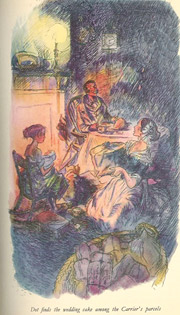 The final stave sees the complete, and sustained, transformation of Scrooge - "...to Tiny Tim, who did NOT die, he was a second father. He became as good a friend, as good a master, and as good a man as the good old City knew, or any other good old city, town, or borough in the good old world."
The final stave sees the complete, and sustained, transformation of Scrooge - "...to Tiny Tim, who did NOT die, he was a second father. He became as good a friend, as good a master, and as good a man as the good old City knew, or any other good old city, town, or borough in the good old world."
In writing A Christmas Carol Charles Dickens was motivated by real concern for the welfare of the poorest section of the population. He had suffered considerable personal hardship and poverty during his upbringing and echoes of this can be seen in descriptions throughout the book: "Alleys and archways, like so many cesspools, disgorged their offences of smell and dirt, and life upon the straggling street; and the whole quarter reeked with crime, with filth, and misery."
Dickens was keenly interested in the welfare of poor children in the cities and believed that education was the key to improving the childrens' lives. This interest is reflected in his descriptions of Ignorance and Want, depicted as two children huddled for protection beneath the cloak of the Ghost of Christmas Present - Scrooge is warned especially to beware of Ignorance. Dickens became a supportor of the Ragged Schools in which the children of poor families received education without being charged fees, though compulsory education for all was not introduced until 1870, the year of Dickens' death.
Right: Illustration by William Littlewood.
A number of twentieth-century illustrators produced artwork for A Christmas Carol, including Charles Pears (1905), Honor C. Appleton (1914), Gordon Robinson(1916), Harold Copping (1920), Gilbert Wilkinson (1930), Emil Weiss (1944),Ronald Searle (1961) and many others.
However, arguably the finest edition is that illustrated by Arthur Rackham, whose trade and signed limited editions appeared in 1915. At the time of writing we have a handsome Rackham edition, limited to just 525 copies, signed by the illustrator, and bound in cream vellum.
We hope you enjoyed this article about Charles Dickens' best known work - to see our stock of other Dickens books, please click here.
Submitted by Tim
(Published on 2nd Dec 2014 )

